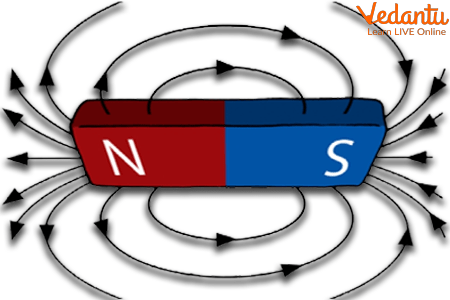




How Do the Poles of a Magnet Work? Essential Facts for Students
Science is our understanding of how the world functions, and whether or not we grasp it. People have been utilising magnets practically as compasses for almost as long as they have been aware of magnets, which date back thousands of years.

Magnetic Poles
It is nice to play with magnets. You seem to be wielding a magic wand! Magnets are objects made of metal or rock that have the uncanny ability to draw certain types of metal. We refer to that strength as a force. A force is something that pushes or pulls in the natural world. The force that prevents you from floating off the earth is gravity. A magnet sticks to your refrigerator thanks to magnetism.
Types of Poles of a Magnet
So now the question arises, how many poles does a magnet have? So there are two poles in a magnet. The two poles of the magnet are the north and south poles. The poles of a magnet are its ends. The pole at the beginning or end is called the North Pole and the other is called the South Pole. Two magnets will attract one another if you position them so that their south poles are facing each other's north poles. Attraction is what we call this.

Poles of a Magnet
The magnets will push apart if you arrange the magnets so that two of the same poles are facing one another. Repulsion is the word for this. Similar poles repel one another whereas opposite poles attract.
North and South Pole Magnets
A north magnetic pole is any pole that seeks the north, such as the north-seeking pole of this type of magnet. A south magnetic pole is the south-seeking pole or any pole that resembles it. Different magnets, unlike poles, pull together while their similar poles repel one another.

North and South Pole of a Magnet
Our planet has a magnetic field because it resembles a large magnet. The magnetic field of the Earth shields humans from solar radiation. Northern and southern lights are colourful light displays that occur naturally at the North and South poles. Sprays of energy from the sun colliding with the Earth's magnetic field results in these lights.
Attracting Magnets Vs Opposite Magnets
There are north and south poles on every magnet. Two poles that are incompatible with one another are drawn together. The North and south poles will reject one another if you try to align them in these directions. A magnetic field that is unseen but contains potential energy surrounds the magnets.

Attracting Magnets and Opposite Magnets
The Magnets, say, the North Pole of a magnet when brought in contact with the South Pole of another magnet attracts each other. So, this is known as attracting magnets. Similarly, say, the North Pole of a magnet when brought in contact with the North Pole of another magnet opposes each other. So, these are known as opposite magnets.
Uses of Magnets
Magnets are used in many different ways in our daily lives, even in some unexpected areas! Here are a few uses for magnets:
Electricity can affect magnets, which makes them an extremely important component of machines and computers.
The doors to refrigerators and freezers are sealed tightly by magnets. They provide electricity for televisions, earbuds and stereo speakers.
In addition to being crucial components of MRIs, which are scanning devices used by doctors to examine patients' internal organs, magnets are also used in computers to store data.
Summary
A magnet is a natural or man-made structure that can create a magnetic field all around it. A magnet's magnetic field causes it to attract or repel other magnets and ferromagnetic elements like iron filings. The north-south direction is always pointed in the direction of magnets hanging through a string.
Now, at the end of this article, we can answer questions like how many poles a magnet has, one can name the two poles of the magnet, the uses of magnets, north and south pole magnets and many more.
FAQs on Poles of a Magnet: Definitions, Concepts & Practice
1. What are the poles of a magnet?
Every magnet has two ends where its magnetic strength is most concentrated. These ends are called the poles of the magnet. One pole is known as the North Pole (N), and the other is the South Pole (S). These poles always exist in pairs.
2. Where are the poles of a magnet located?
The poles of a magnet are located at the points where the magnetic force is the strongest. Their location depends on the magnet's shape:
- In a bar magnet, the poles are at its two opposite ends.
- In a horseshoe magnet, the poles are at the two free tips of the 'U' shape.
- For a disc or ring magnet, the poles are on the opposite flat faces.
3. What are the main properties of magnetic poles?
The poles of a magnet follow two fundamental laws of interaction:
- Like poles repel: When the North Pole of one magnet is brought near the North Pole of another, they push each other away. The same happens with two South Poles.
- Unlike poles attract: The North Pole of one magnet will pull towards the South Pole of another, and they will stick together.
4. What happens to the poles if you break a magnet in half?
If you break a bar magnet in half, you do not get a separate North Pole and a separate South Pole. Instead, you create two new, smaller magnets. Each new piece will immediately have its own North and South Pole. This demonstrates that magnetic monopoles (single poles) do not exist in nature.
5. How can you find the poles of an unmarked magnet?
You can identify the poles of an unmarked magnet by suspending it freely from a string. It will naturally align itself with the Earth's magnetic field. The end of the magnet that points towards the Earth's geographic North is the magnet's North Pole, and the end that points towards the geographic South is its South Pole.
6. What is the difference between the Earth's geographic North Pole and a magnet's North Pole?
A magnet's North Pole is defined as the pole that seeks, or points towards, the Earth's geographic North Pole. Because unlike poles attract, this means the area we call the geographic North Pole actually behaves like a magnetic south pole. This is why the north-seeking end of a compass needle points north.
7. Are the North and South poles of a magnet positive and negative?
No, magnetic poles are not the same as electric charges. It is a common misconception to label the North pole as 'positive' and the South pole as 'negative'. Magnetism is a different physical phenomenon from static electricity. The terms North and South refer only to their magnetic orientation and interaction with the Earth's magnetic field.
8. Which is the strongest natural magnet found on Earth?
The strongest naturally occurring magnet is a mineral called magnetite, which is also known as lodestone. It is a type of iron oxide that was discovered in ancient times. People observed that it could attract small pieces of iron and would align itself north-south if floated on water.









